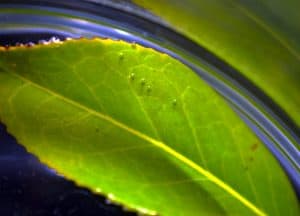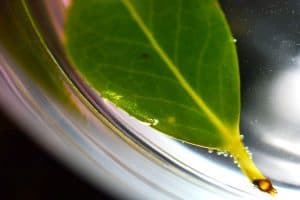

Respiration in plants is the process used by plants to convert nutrients into energy that fuel cellular activities. Photosynthesis is the process where light energy is converted into chemical energy that can later be used in respiration.
Essentially, during respiration, plants consume nutrients to keep plant cells alive while during photosynthesis, plants create their own food.

Simplified Reactions
Respiration: oxygen + glucose -> carbon dioxide + water + heat energy
Photosynthesis: carbon dioxide + water+ light energy -> oxygen + glucose
Gas Exchange
During both respiration and photosynthesis, gases enter and leave the plants through the stomata (holes on the leaves).
In this neat and simple experiment, we can see the gas exchange processes in action to a degree.
What You Need
- a bowl of water
- plant in question, e.g. a flower or a leaf. Pick it from a living plant, not one that has fallen onto the ground.
- sunlight
Steps
- Submerge the plant into the bowl of water. The flower or leaf may float to the top, but try to make at least part of the plant stay underwater.
- Put the bowl under the sunlight and wait.
- After an hour, observe the plant’s surface. There should be some air bubbles formed on the pedals or the leaf.
- Observe different parts of the plant. Do air bubbles form everywhere?



Why
Plants respire all the time, during the day and during the night. On the other hand, photosynthesize only occurs during the day when there is sunlight on parts of the plant that contain chlorophyll (green).
During daytime, plants product oxygen more than they consume. That is why plants are so important to our and other animals’ survival as we need oxygen to stay alive.
Oxygen and carbon dioxide pass in and out of the stomata in the plants through diffusion. When the plant is submerged in the water, bubbles of oxygen or carbon dioxide released are trapped and they stick on the leaves or petals temporarily. Since these gases are lighter than water, if you shake the plant, the bubbles will quickly rise to the surface and burst. It’s similar to you releasing a breath underwater.
Original article and pictures take http://www.rookieparenting.com/do-plants-breathe-science-experiment/ site
Комментариев нет:
Отправить комментарий